Contract and Negligence Law Report
VerifiedAdded on 2020/02/03
|17
|5494
|154
Report
AI Summary
This report provides a detailed analysis of contract and negligence law principles within a business context. It covers essential elements of a valid contract, including offer, acceptance, consideration, and capacity. Different types of contracts are discussed, along with the impact of various terms (conditions, warranties, innominate terms). The report then contrasts contractual liability with liability in tort, focusing on negligence. It explains vicarious liability and how businesses can be held responsible for the actions of their employees. Several case studies are analyzed to illustrate the application of legal principles, including discussions of implied terms, breach of contract, and defenses against negligence claims. The report concludes by emphasizing the importance of corporate training in mitigating vicarious liability risks.
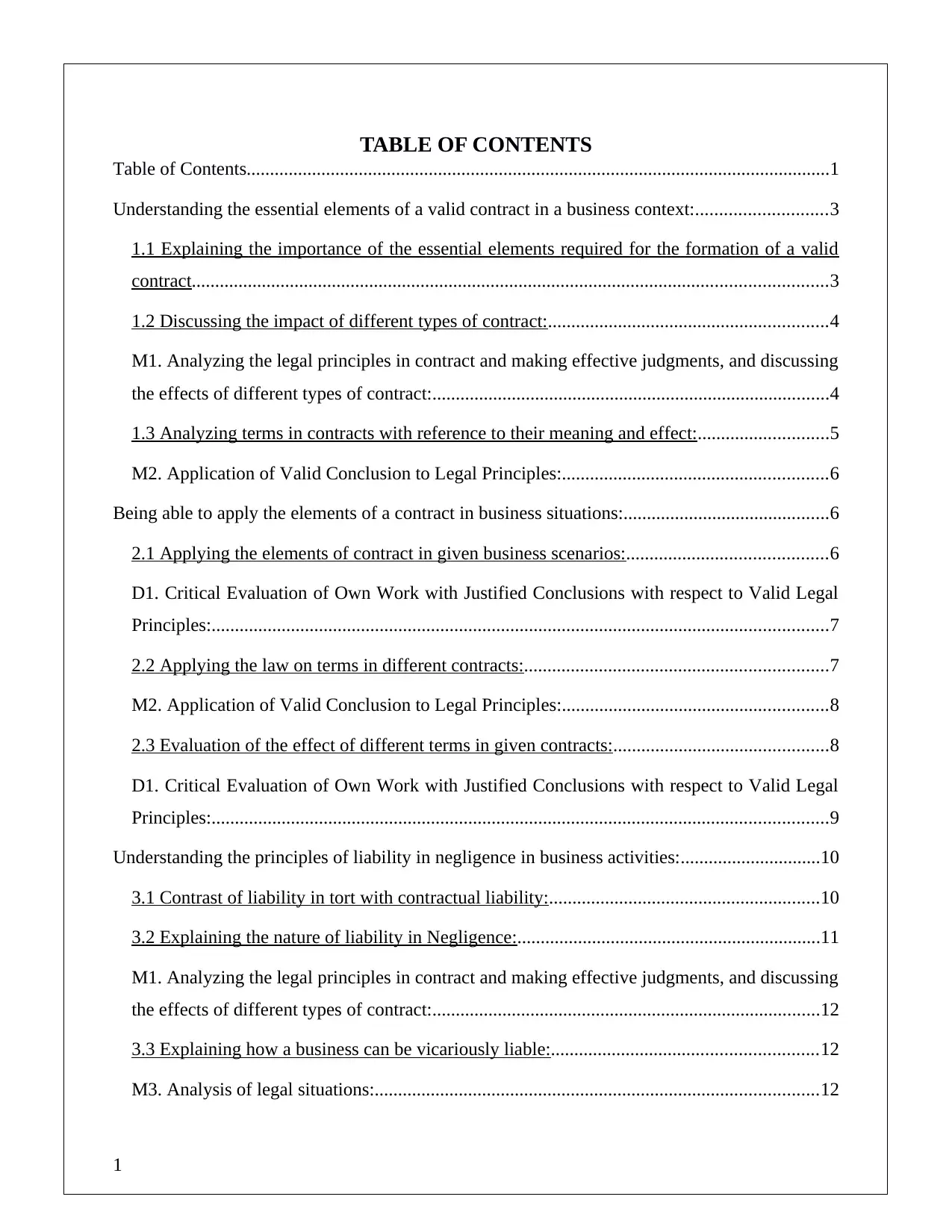
TABLE OF CONTENTS
Table of Contents.............................................................................................................................1
Understanding the essential elements of a valid contract in a business context:............................3
1.1 Explaining the importance of the essential elements required for the formation of a valid
contract........................................................................................................................................3
1.2 Discussing the impact of different types of contract:............................................................4
M1. Analyzing the legal principles in contract and making effective judgments, and discussing
the effects of different types of contract:.....................................................................................4
1.3 Analyzing terms in contracts with reference to their meaning and effect:............................5
M2. Application of Valid Conclusion to Legal Principles:.........................................................6
Being able to apply the elements of a contract in business situations:............................................6
2.1 Applying the elements of contract in given business scenarios:...........................................6
D1. Critical Evaluation of Own Work with Justified Conclusions with respect to Valid Legal
Principles:....................................................................................................................................7
2.2 Applying the law on terms in different contracts:.................................................................7
M2. Application of Valid Conclusion to Legal Principles:.........................................................8
2.3 Evaluation of the effect of different terms in given contracts:..............................................8
D1. Critical Evaluation of Own Work with Justified Conclusions with respect to Valid Legal
Principles:....................................................................................................................................9
Understanding the principles of liability in negligence in business activities:..............................10
3.1 Contrast of liability in tort with contractual liability:..........................................................10
3.2 Explaining the nature of liability in Negligence:.................................................................11
M1. Analyzing the legal principles in contract and making effective judgments, and discussing
the effects of different types of contract:...................................................................................12
3.3 Explaining how a business can be vicariously liable:.........................................................12
M3. Analysis of legal situations:...............................................................................................12
1
Table of Contents.............................................................................................................................1
Understanding the essential elements of a valid contract in a business context:............................3
1.1 Explaining the importance of the essential elements required for the formation of a valid
contract........................................................................................................................................3
1.2 Discussing the impact of different types of contract:............................................................4
M1. Analyzing the legal principles in contract and making effective judgments, and discussing
the effects of different types of contract:.....................................................................................4
1.3 Analyzing terms in contracts with reference to their meaning and effect:............................5
M2. Application of Valid Conclusion to Legal Principles:.........................................................6
Being able to apply the elements of a contract in business situations:............................................6
2.1 Applying the elements of contract in given business scenarios:...........................................6
D1. Critical Evaluation of Own Work with Justified Conclusions with respect to Valid Legal
Principles:....................................................................................................................................7
2.2 Applying the law on terms in different contracts:.................................................................7
M2. Application of Valid Conclusion to Legal Principles:.........................................................8
2.3 Evaluation of the effect of different terms in given contracts:..............................................8
D1. Critical Evaluation of Own Work with Justified Conclusions with respect to Valid Legal
Principles:....................................................................................................................................9
Understanding the principles of liability in negligence in business activities:..............................10
3.1 Contrast of liability in tort with contractual liability:..........................................................10
3.2 Explaining the nature of liability in Negligence:.................................................................11
M1. Analyzing the legal principles in contract and making effective judgments, and discussing
the effects of different types of contract:...................................................................................12
3.3 Explaining how a business can be vicariously liable:.........................................................12
M3. Analysis of legal situations:...............................................................................................12
1
Paraphrase This Document
Need a fresh take? Get an instant paraphrase of this document with our AI Paraphraser
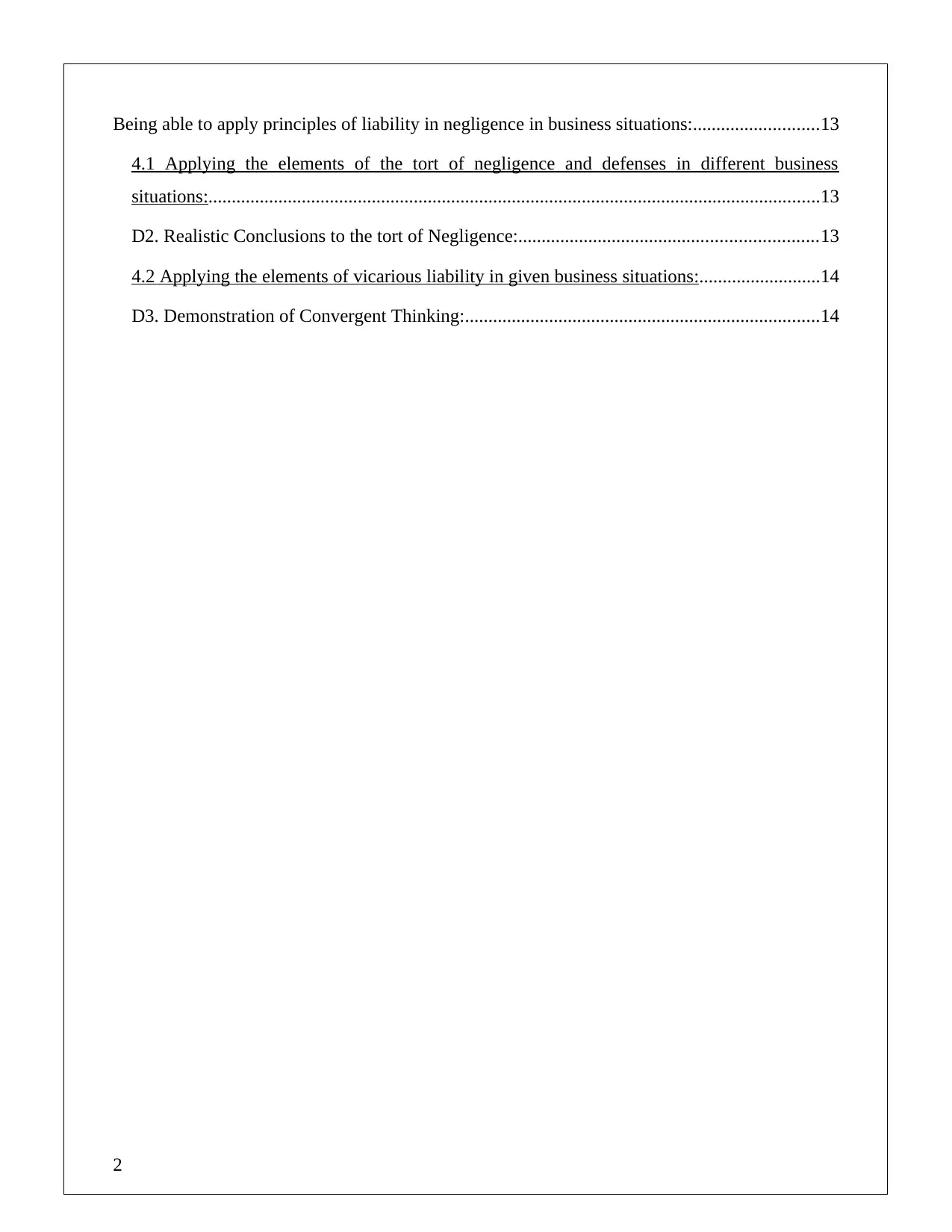
Being able to apply principles of liability in negligence in business situations:...........................13
4.1 Applying the elements of the tort of negligence and defenses in different business
situations:...................................................................................................................................13
D2. Realistic Conclusions to the tort of Negligence:................................................................13
4.2 Applying the elements of vicarious liability in given business situations:..........................14
D3. Demonstration of Convergent Thinking:............................................................................14
2
4.1 Applying the elements of the tort of negligence and defenses in different business
situations:...................................................................................................................................13
D2. Realistic Conclusions to the tort of Negligence:................................................................13
4.2 Applying the elements of vicarious liability in given business situations:..........................14
D3. Demonstration of Convergent Thinking:............................................................................14
2
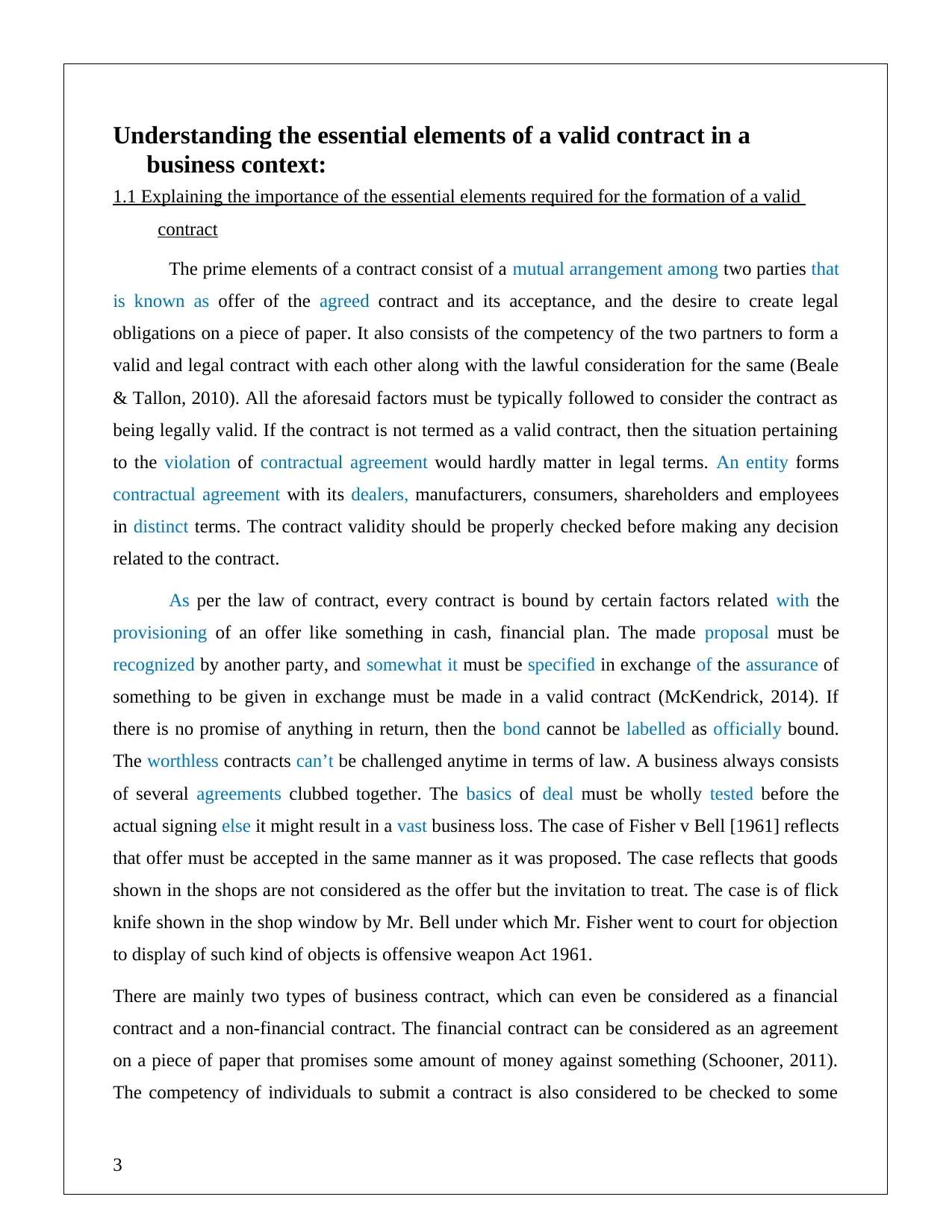
Understanding the essential elements of a valid contract in a
business context:
1.1 Explaining the importance of the essential elements required for the formation of a valid
contract
The prime elements of a contract consist of a mutual arrangement among two parties that
is known as offer of the agreed contract and its acceptance, and the desire to create legal
obligations on a piece of paper. It also consists of the competency of the two partners to form a
valid and legal contract with each other along with the lawful consideration for the same (Beale
& Tallon, 2010). All the aforesaid factors must be typically followed to consider the contract as
being legally valid. If the contract is not termed as a valid contract, then the situation pertaining
to the violation of contractual agreement would hardly matter in legal terms. An entity forms
contractual agreement with its dealers, manufacturers, consumers, shareholders and employees
in distinct terms. The contract validity should be properly checked before making any decision
related to the contract.
As per the law of contract, every contract is bound by certain factors related with the
provisioning of an offer like something in cash, financial plan. The made proposal must be
recognized by another party, and somewhat it must be specified in exchange of the assurance of
something to be given in exchange must be made in a valid contract (McKendrick, 2014). If
there is no promise of anything in return, then the bond cannot be labelled as officially bound.
The worthless contracts can’t be challenged anytime in terms of law. A business always consists
of several agreements clubbed together. The basics of deal must be wholly tested before the
actual signing else it might result in a vast business loss. The case of Fisher v Bell [1961] reflects
that offer must be accepted in the same manner as it was proposed. The case reflects that goods
shown in the shops are not considered as the offer but the invitation to treat. The case is of flick
knife shown in the shop window by Mr. Bell under which Mr. Fisher went to court for objection
to display of such kind of objects is offensive weapon Act 1961.
There are mainly two types of business contract, which can even be considered as a financial
contract and a non-financial contract. The financial contract can be considered as an agreement
on a piece of paper that promises some amount of money against something (Schooner, 2011).
The competency of individuals to submit a contract is also considered to be checked to some
3
business context:
1.1 Explaining the importance of the essential elements required for the formation of a valid
contract
The prime elements of a contract consist of a mutual arrangement among two parties that
is known as offer of the agreed contract and its acceptance, and the desire to create legal
obligations on a piece of paper. It also consists of the competency of the two partners to form a
valid and legal contract with each other along with the lawful consideration for the same (Beale
& Tallon, 2010). All the aforesaid factors must be typically followed to consider the contract as
being legally valid. If the contract is not termed as a valid contract, then the situation pertaining
to the violation of contractual agreement would hardly matter in legal terms. An entity forms
contractual agreement with its dealers, manufacturers, consumers, shareholders and employees
in distinct terms. The contract validity should be properly checked before making any decision
related to the contract.
As per the law of contract, every contract is bound by certain factors related with the
provisioning of an offer like something in cash, financial plan. The made proposal must be
recognized by another party, and somewhat it must be specified in exchange of the assurance of
something to be given in exchange must be made in a valid contract (McKendrick, 2014). If
there is no promise of anything in return, then the bond cannot be labelled as officially bound.
The worthless contracts can’t be challenged anytime in terms of law. A business always consists
of several agreements clubbed together. The basics of deal must be wholly tested before the
actual signing else it might result in a vast business loss. The case of Fisher v Bell [1961] reflects
that offer must be accepted in the same manner as it was proposed. The case reflects that goods
shown in the shops are not considered as the offer but the invitation to treat. The case is of flick
knife shown in the shop window by Mr. Bell under which Mr. Fisher went to court for objection
to display of such kind of objects is offensive weapon Act 1961.
There are mainly two types of business contract, which can even be considered as a financial
contract and a non-financial contract. The financial contract can be considered as an agreement
on a piece of paper that promises some amount of money against something (Schooner, 2011).
The competency of individuals to submit a contract is also considered to be checked to some
3
⊘ This is a preview!⊘
Do you want full access?
Subscribe today to unlock all pages.

Trusted by 1+ million students worldwide
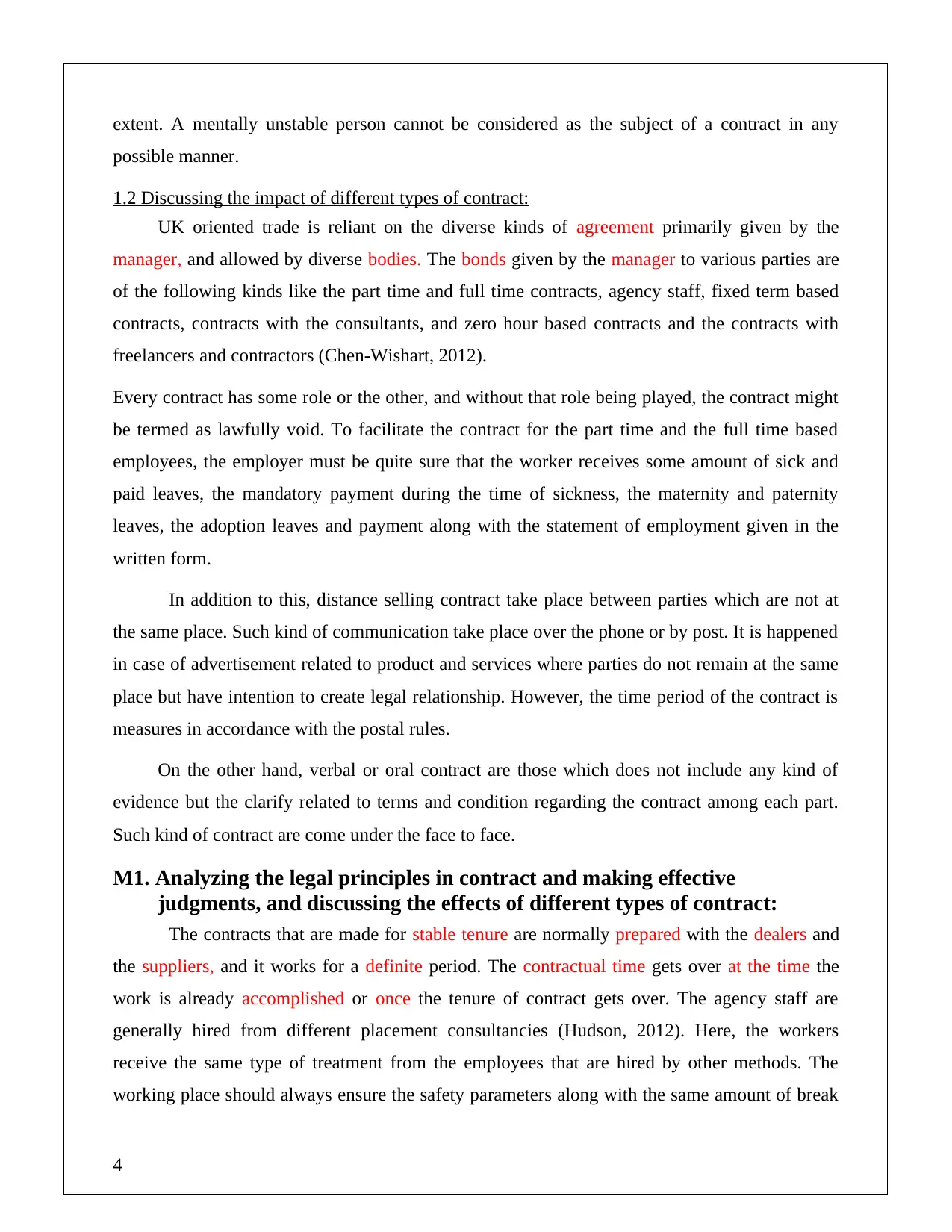
extent. A mentally unstable person cannot be considered as the subject of a contract in any
possible manner.
1.2 Discussing the impact of different types of contract:
UK oriented trade is reliant on the diverse kinds of agreement primarily given by the
manager, and allowed by diverse bodies. The bonds given by the manager to various parties are
of the following kinds like the part time and full time contracts, agency staff, fixed term based
contracts, contracts with the consultants, and zero hour based contracts and the contracts with
freelancers and contractors (Chen-Wishart, 2012).
Every contract has some role or the other, and without that role being played, the contract might
be termed as lawfully void. To facilitate the contract for the part time and the full time based
employees, the employer must be quite sure that the worker receives some amount of sick and
paid leaves, the mandatory payment during the time of sickness, the maternity and paternity
leaves, the adoption leaves and payment along with the statement of employment given in the
written form.
In addition to this, distance selling contract take place between parties which are not at
the same place. Such kind of communication take place over the phone or by post. It is happened
in case of advertisement related to product and services where parties do not remain at the same
place but have intention to create legal relationship. However, the time period of the contract is
measures in accordance with the postal rules.
On the other hand, verbal or oral contract are those which does not include any kind of
evidence but the clarify related to terms and condition regarding the contract among each part.
Such kind of contract are come under the face to face.
M1. Analyzing the legal principles in contract and making effective
judgments, and discussing the effects of different types of contract:
The contracts that are made for stable tenure are normally prepared with the dealers and
the suppliers, and it works for a definite period. The contractual time gets over at the time the
work is already accomplished or once the tenure of contract gets over. The agency staff are
generally hired from different placement consultancies (Hudson, 2012). Here, the workers
receive the same type of treatment from the employees that are hired by other methods. The
working place should always ensure the safety parameters along with the same amount of break
4
possible manner.
1.2 Discussing the impact of different types of contract:
UK oriented trade is reliant on the diverse kinds of agreement primarily given by the
manager, and allowed by diverse bodies. The bonds given by the manager to various parties are
of the following kinds like the part time and full time contracts, agency staff, fixed term based
contracts, contracts with the consultants, and zero hour based contracts and the contracts with
freelancers and contractors (Chen-Wishart, 2012).
Every contract has some role or the other, and without that role being played, the contract might
be termed as lawfully void. To facilitate the contract for the part time and the full time based
employees, the employer must be quite sure that the worker receives some amount of sick and
paid leaves, the mandatory payment during the time of sickness, the maternity and paternity
leaves, the adoption leaves and payment along with the statement of employment given in the
written form.
In addition to this, distance selling contract take place between parties which are not at
the same place. Such kind of communication take place over the phone or by post. It is happened
in case of advertisement related to product and services where parties do not remain at the same
place but have intention to create legal relationship. However, the time period of the contract is
measures in accordance with the postal rules.
On the other hand, verbal or oral contract are those which does not include any kind of
evidence but the clarify related to terms and condition regarding the contract among each part.
Such kind of contract are come under the face to face.
M1. Analyzing the legal principles in contract and making effective
judgments, and discussing the effects of different types of contract:
The contracts that are made for stable tenure are normally prepared with the dealers and
the suppliers, and it works for a definite period. The contractual time gets over at the time the
work is already accomplished or once the tenure of contract gets over. The agency staff are
generally hired from different placement consultancies (Hudson, 2012). Here, the workers
receive the same type of treatment from the employees that are hired by other methods. The
working place should always ensure the safety parameters along with the same amount of break
4
Paraphrase This Document
Need a fresh take? Get an instant paraphrase of this document with our AI Paraphraser
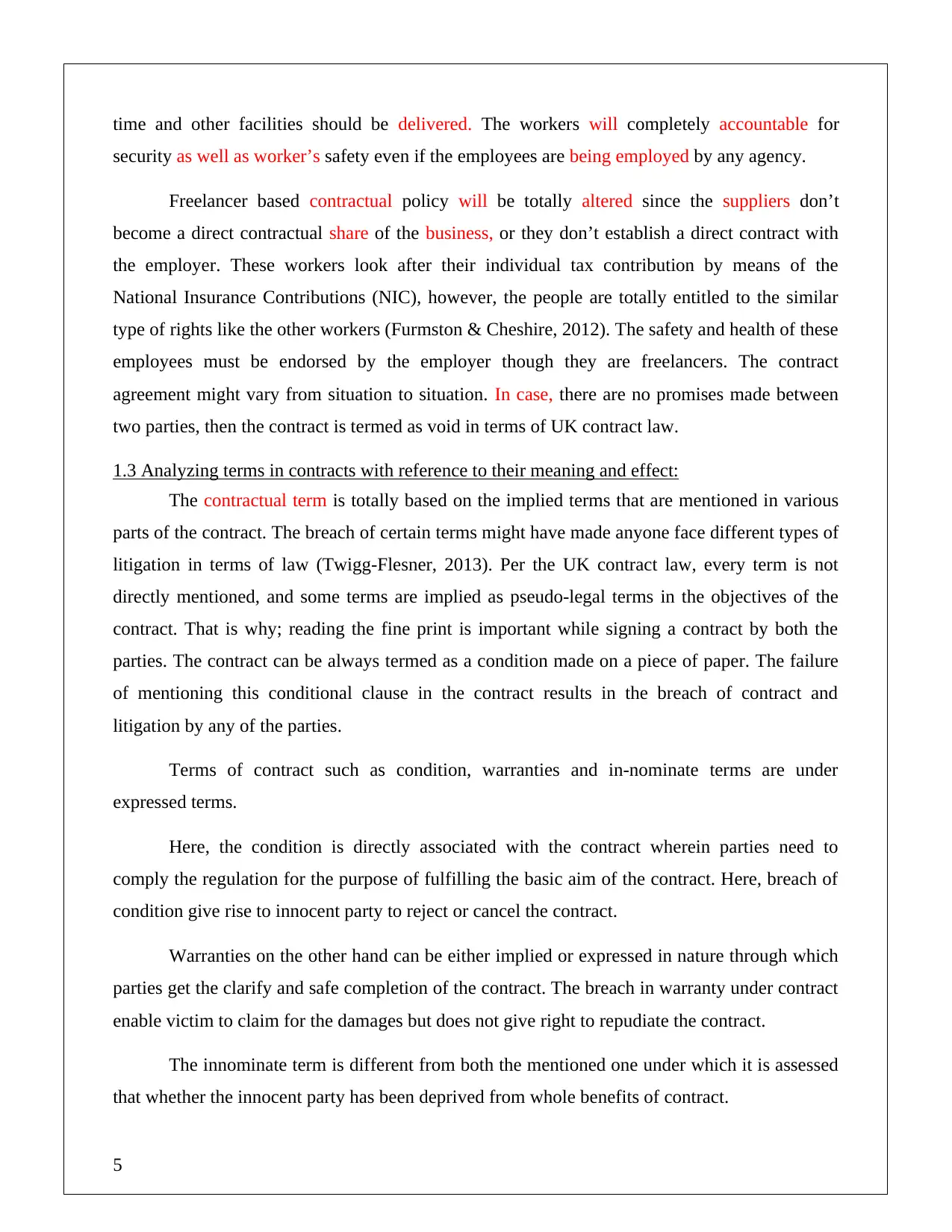
time and other facilities should be delivered. The workers will completely accountable for
security as well as worker’s safety even if the employees are being employed by any agency.
Freelancer based contractual policy will be totally altered since the suppliers don’t
become a direct contractual share of the business, or they don’t establish a direct contract with
the employer. These workers look after their individual tax contribution by means of the
National Insurance Contributions (NIC), however, the people are totally entitled to the similar
type of rights like the other workers (Furmston & Cheshire, 2012). The safety and health of these
employees must be endorsed by the employer though they are freelancers. The contract
agreement might vary from situation to situation. In case, there are no promises made between
two parties, then the contract is termed as void in terms of UK contract law.
1.3 Analyzing terms in contracts with reference to their meaning and effect:
The contractual term is totally based on the implied terms that are mentioned in various
parts of the contract. The breach of certain terms might have made anyone face different types of
litigation in terms of law (Twigg-Flesner, 2013). Per the UK contract law, every term is not
directly mentioned, and some terms are implied as pseudo-legal terms in the objectives of the
contract. That is why; reading the fine print is important while signing a contract by both the
parties. The contract can be always termed as a condition made on a piece of paper. The failure
of mentioning this conditional clause in the contract results in the breach of contract and
litigation by any of the parties.
Terms of contract such as condition, warranties and in-nominate terms are under
expressed terms.
Here, the condition is directly associated with the contract wherein parties need to
comply the regulation for the purpose of fulfilling the basic aim of the contract. Here, breach of
condition give rise to innocent party to reject or cancel the contract.
Warranties on the other hand can be either implied or expressed in nature through which
parties get the clarify and safe completion of the contract. The breach in warranty under contract
enable victim to claim for the damages but does not give right to repudiate the contract.
The innominate term is different from both the mentioned one under which it is assessed
that whether the innocent party has been deprived from whole benefits of contract.
5
security as well as worker’s safety even if the employees are being employed by any agency.
Freelancer based contractual policy will be totally altered since the suppliers don’t
become a direct contractual share of the business, or they don’t establish a direct contract with
the employer. These workers look after their individual tax contribution by means of the
National Insurance Contributions (NIC), however, the people are totally entitled to the similar
type of rights like the other workers (Furmston & Cheshire, 2012). The safety and health of these
employees must be endorsed by the employer though they are freelancers. The contract
agreement might vary from situation to situation. In case, there are no promises made between
two parties, then the contract is termed as void in terms of UK contract law.
1.3 Analyzing terms in contracts with reference to their meaning and effect:
The contractual term is totally based on the implied terms that are mentioned in various
parts of the contract. The breach of certain terms might have made anyone face different types of
litigation in terms of law (Twigg-Flesner, 2013). Per the UK contract law, every term is not
directly mentioned, and some terms are implied as pseudo-legal terms in the objectives of the
contract. That is why; reading the fine print is important while signing a contract by both the
parties. The contract can be always termed as a condition made on a piece of paper. The failure
of mentioning this conditional clause in the contract results in the breach of contract and
litigation by any of the parties.
Terms of contract such as condition, warranties and in-nominate terms are under
expressed terms.
Here, the condition is directly associated with the contract wherein parties need to
comply the regulation for the purpose of fulfilling the basic aim of the contract. Here, breach of
condition give rise to innocent party to reject or cancel the contract.
Warranties on the other hand can be either implied or expressed in nature through which
parties get the clarify and safe completion of the contract. The breach in warranty under contract
enable victim to claim for the damages but does not give right to repudiate the contract.
The innominate term is different from both the mentioned one under which it is assessed
that whether the innocent party has been deprived from whole benefits of contract.
5
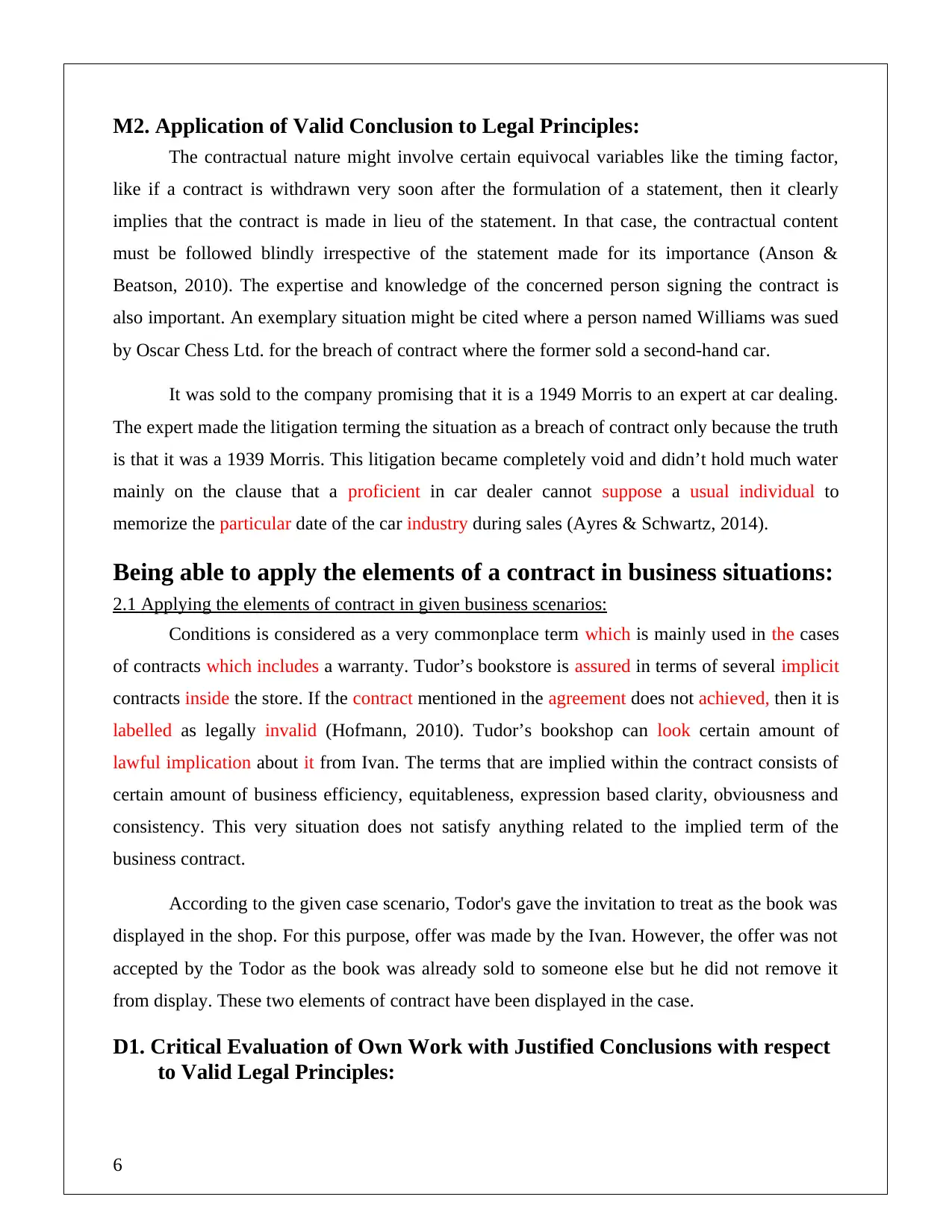
M2. Application of Valid Conclusion to Legal Principles:
The contractual nature might involve certain equivocal variables like the timing factor,
like if a contract is withdrawn very soon after the formulation of a statement, then it clearly
implies that the contract is made in lieu of the statement. In that case, the contractual content
must be followed blindly irrespective of the statement made for its importance (Anson &
Beatson, 2010). The expertise and knowledge of the concerned person signing the contract is
also important. An exemplary situation might be cited where a person named Williams was sued
by Oscar Chess Ltd. for the breach of contract where the former sold a second-hand car.
It was sold to the company promising that it is a 1949 Morris to an expert at car dealing.
The expert made the litigation terming the situation as a breach of contract only because the truth
is that it was a 1939 Morris. This litigation became completely void and didn’t hold much water
mainly on the clause that a proficient in car dealer cannot suppose a usual individual to
memorize the particular date of the car industry during sales (Ayres & Schwartz, 2014).
Being able to apply the elements of a contract in business situations:
2.1 Applying the elements of contract in given business scenarios:
Conditions is considered as a very commonplace term which is mainly used in the cases
of contracts which includes a warranty. Tudor’s bookstore is assured in terms of several implicit
contracts inside the store. If the contract mentioned in the agreement does not achieved, then it is
labelled as legally invalid (Hofmann, 2010). Tudor’s bookshop can look certain amount of
lawful implication about it from Ivan. The terms that are implied within the contract consists of
certain amount of business efficiency, equitableness, expression based clarity, obviousness and
consistency. This very situation does not satisfy anything related to the implied term of the
business contract.
According to the given case scenario, Todor's gave the invitation to treat as the book was
displayed in the shop. For this purpose, offer was made by the Ivan. However, the offer was not
accepted by the Todor as the book was already sold to someone else but he did not remove it
from display. These two elements of contract have been displayed in the case.
D1. Critical Evaluation of Own Work with Justified Conclusions with respect
to Valid Legal Principles:
6
The contractual nature might involve certain equivocal variables like the timing factor,
like if a contract is withdrawn very soon after the formulation of a statement, then it clearly
implies that the contract is made in lieu of the statement. In that case, the contractual content
must be followed blindly irrespective of the statement made for its importance (Anson &
Beatson, 2010). The expertise and knowledge of the concerned person signing the contract is
also important. An exemplary situation might be cited where a person named Williams was sued
by Oscar Chess Ltd. for the breach of contract where the former sold a second-hand car.
It was sold to the company promising that it is a 1949 Morris to an expert at car dealing.
The expert made the litigation terming the situation as a breach of contract only because the truth
is that it was a 1939 Morris. This litigation became completely void and didn’t hold much water
mainly on the clause that a proficient in car dealer cannot suppose a usual individual to
memorize the particular date of the car industry during sales (Ayres & Schwartz, 2014).
Being able to apply the elements of a contract in business situations:
2.1 Applying the elements of contract in given business scenarios:
Conditions is considered as a very commonplace term which is mainly used in the cases
of contracts which includes a warranty. Tudor’s bookstore is assured in terms of several implicit
contracts inside the store. If the contract mentioned in the agreement does not achieved, then it is
labelled as legally invalid (Hofmann, 2010). Tudor’s bookshop can look certain amount of
lawful implication about it from Ivan. The terms that are implied within the contract consists of
certain amount of business efficiency, equitableness, expression based clarity, obviousness and
consistency. This very situation does not satisfy anything related to the implied term of the
business contract.
According to the given case scenario, Todor's gave the invitation to treat as the book was
displayed in the shop. For this purpose, offer was made by the Ivan. However, the offer was not
accepted by the Todor as the book was already sold to someone else but he did not remove it
from display. These two elements of contract have been displayed in the case.
D1. Critical Evaluation of Own Work with Justified Conclusions with respect
to Valid Legal Principles:
6
⊘ This is a preview!⊘
Do you want full access?
Subscribe today to unlock all pages.

Trusted by 1+ million students worldwide
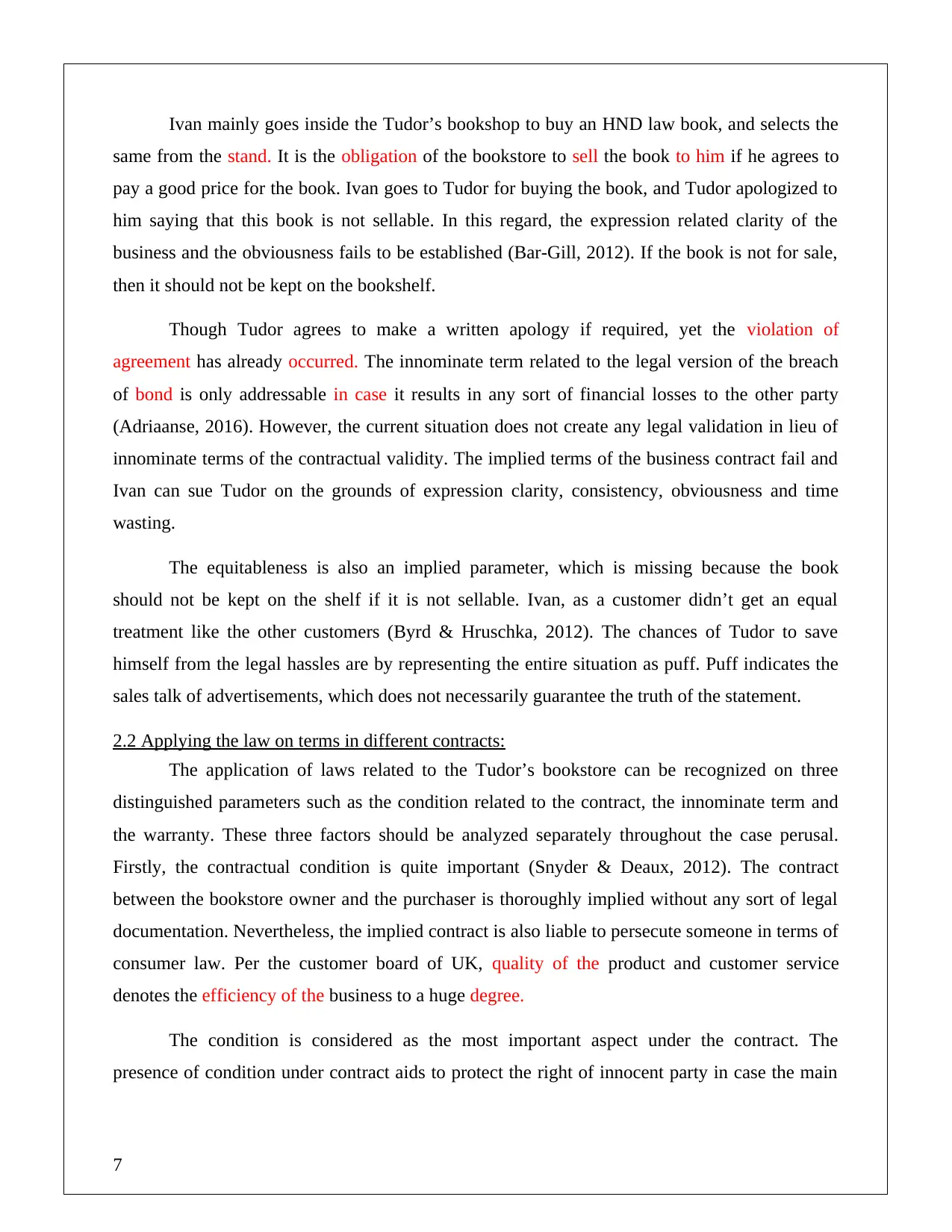
Ivan mainly goes inside the Tudor’s bookshop to buy an HND law book, and selects the
same from the stand. It is the obligation of the bookstore to sell the book to him if he agrees to
pay a good price for the book. Ivan goes to Tudor for buying the book, and Tudor apologized to
him saying that this book is not sellable. In this regard, the expression related clarity of the
business and the obviousness fails to be established (Bar-Gill, 2012). If the book is not for sale,
then it should not be kept on the bookshelf.
Though Tudor agrees to make a written apology if required, yet the violation of
agreement has already occurred. The innominate term related to the legal version of the breach
of bond is only addressable in case it results in any sort of financial losses to the other party
(Adriaanse, 2016). However, the current situation does not create any legal validation in lieu of
innominate terms of the contractual validity. The implied terms of the business contract fail and
Ivan can sue Tudor on the grounds of expression clarity, consistency, obviousness and time
wasting.
The equitableness is also an implied parameter, which is missing because the book
should not be kept on the shelf if it is not sellable. Ivan, as a customer didn’t get an equal
treatment like the other customers (Byrd & Hruschka, 2012). The chances of Tudor to save
himself from the legal hassles are by representing the entire situation as puff. Puff indicates the
sales talk of advertisements, which does not necessarily guarantee the truth of the statement.
2.2 Applying the law on terms in different contracts:
The application of laws related to the Tudor’s bookstore can be recognized on three
distinguished parameters such as the condition related to the contract, the innominate term and
the warranty. These three factors should be analyzed separately throughout the case perusal.
Firstly, the contractual condition is quite important (Snyder & Deaux, 2012). The contract
between the bookstore owner and the purchaser is thoroughly implied without any sort of legal
documentation. Nevertheless, the implied contract is also liable to persecute someone in terms of
consumer law. Per the customer board of UK, quality of the product and customer service
denotes the efficiency of the business to a huge degree.
The condition is considered as the most important aspect under the contract. The
presence of condition under contract aids to protect the right of innocent party in case the main
7
same from the stand. It is the obligation of the bookstore to sell the book to him if he agrees to
pay a good price for the book. Ivan goes to Tudor for buying the book, and Tudor apologized to
him saying that this book is not sellable. In this regard, the expression related clarity of the
business and the obviousness fails to be established (Bar-Gill, 2012). If the book is not for sale,
then it should not be kept on the bookshelf.
Though Tudor agrees to make a written apology if required, yet the violation of
agreement has already occurred. The innominate term related to the legal version of the breach
of bond is only addressable in case it results in any sort of financial losses to the other party
(Adriaanse, 2016). However, the current situation does not create any legal validation in lieu of
innominate terms of the contractual validity. The implied terms of the business contract fail and
Ivan can sue Tudor on the grounds of expression clarity, consistency, obviousness and time
wasting.
The equitableness is also an implied parameter, which is missing because the book
should not be kept on the shelf if it is not sellable. Ivan, as a customer didn’t get an equal
treatment like the other customers (Byrd & Hruschka, 2012). The chances of Tudor to save
himself from the legal hassles are by representing the entire situation as puff. Puff indicates the
sales talk of advertisements, which does not necessarily guarantee the truth of the statement.
2.2 Applying the law on terms in different contracts:
The application of laws related to the Tudor’s bookstore can be recognized on three
distinguished parameters such as the condition related to the contract, the innominate term and
the warranty. These three factors should be analyzed separately throughout the case perusal.
Firstly, the contractual condition is quite important (Snyder & Deaux, 2012). The contract
between the bookstore owner and the purchaser is thoroughly implied without any sort of legal
documentation. Nevertheless, the implied contract is also liable to persecute someone in terms of
consumer law. Per the customer board of UK, quality of the product and customer service
denotes the efficiency of the business to a huge degree.
The condition is considered as the most important aspect under the contract. The
presence of condition under contract aids to protect the right of innocent party in case the main
7
Paraphrase This Document
Need a fresh take? Get an instant paraphrase of this document with our AI Paraphraser
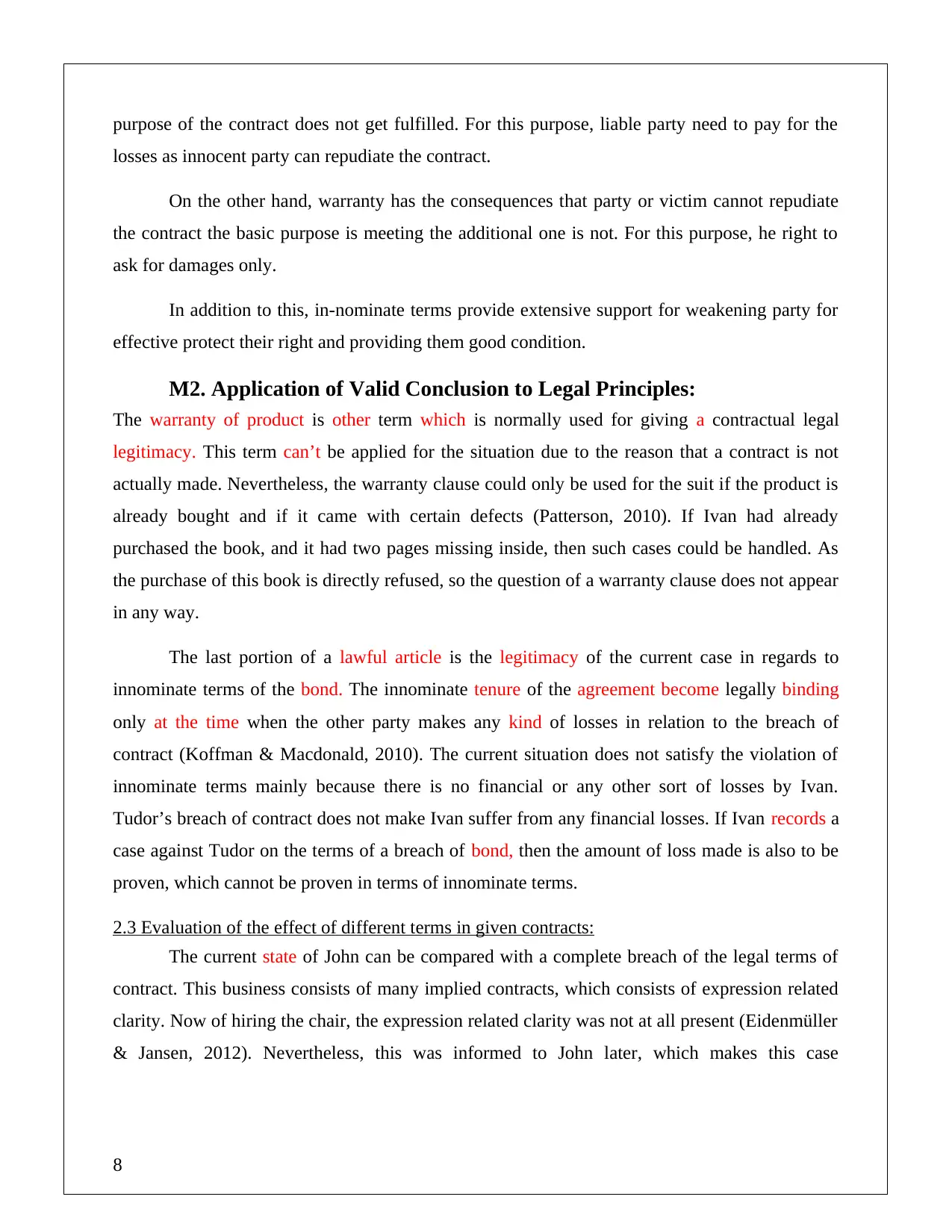
purpose of the contract does not get fulfilled. For this purpose, liable party need to pay for the
losses as innocent party can repudiate the contract.
On the other hand, warranty has the consequences that party or victim cannot repudiate
the contract the basic purpose is meeting the additional one is not. For this purpose, he right to
ask for damages only.
In addition to this, in-nominate terms provide extensive support for weakening party for
effective protect their right and providing them good condition.
M2. Application of Valid Conclusion to Legal Principles:
The warranty of product is other term which is normally used for giving a contractual legal
legitimacy. This term can’t be applied for the situation due to the reason that a contract is not
actually made. Nevertheless, the warranty clause could only be used for the suit if the product is
already bought and if it came with certain defects (Patterson, 2010). If Ivan had already
purchased the book, and it had two pages missing inside, then such cases could be handled. As
the purchase of this book is directly refused, so the question of a warranty clause does not appear
in any way.
The last portion of a lawful article is the legitimacy of the current case in regards to
innominate terms of the bond. The innominate tenure of the agreement become legally binding
only at the time when the other party makes any kind of losses in relation to the breach of
contract (Koffman & Macdonald, 2010). The current situation does not satisfy the violation of
innominate terms mainly because there is no financial or any other sort of losses by Ivan.
Tudor’s breach of contract does not make Ivan suffer from any financial losses. If Ivan records a
case against Tudor on the terms of a breach of bond, then the amount of loss made is also to be
proven, which cannot be proven in terms of innominate terms.
2.3 Evaluation of the effect of different terms in given contracts:
The current state of John can be compared with a complete breach of the legal terms of
contract. This business consists of many implied contracts, which consists of expression related
clarity. Now of hiring the chair, the expression related clarity was not at all present (Eidenmüller
& Jansen, 2012). Nevertheless, this was informed to John later, which makes this case
8
losses as innocent party can repudiate the contract.
On the other hand, warranty has the consequences that party or victim cannot repudiate
the contract the basic purpose is meeting the additional one is not. For this purpose, he right to
ask for damages only.
In addition to this, in-nominate terms provide extensive support for weakening party for
effective protect their right and providing them good condition.
M2. Application of Valid Conclusion to Legal Principles:
The warranty of product is other term which is normally used for giving a contractual legal
legitimacy. This term can’t be applied for the situation due to the reason that a contract is not
actually made. Nevertheless, the warranty clause could only be used for the suit if the product is
already bought and if it came with certain defects (Patterson, 2010). If Ivan had already
purchased the book, and it had two pages missing inside, then such cases could be handled. As
the purchase of this book is directly refused, so the question of a warranty clause does not appear
in any way.
The last portion of a lawful article is the legitimacy of the current case in regards to
innominate terms of the bond. The innominate tenure of the agreement become legally binding
only at the time when the other party makes any kind of losses in relation to the breach of
contract (Koffman & Macdonald, 2010). The current situation does not satisfy the violation of
innominate terms mainly because there is no financial or any other sort of losses by Ivan.
Tudor’s breach of contract does not make Ivan suffer from any financial losses. If Ivan records a
case against Tudor on the terms of a breach of bond, then the amount of loss made is also to be
proven, which cannot be proven in terms of innominate terms.
2.3 Evaluation of the effect of different terms in given contracts:
The current state of John can be compared with a complete breach of the legal terms of
contract. This business consists of many implied contracts, which consists of expression related
clarity. Now of hiring the chair, the expression related clarity was not at all present (Eidenmüller
& Jansen, 2012). Nevertheless, this was informed to John later, which makes this case
8
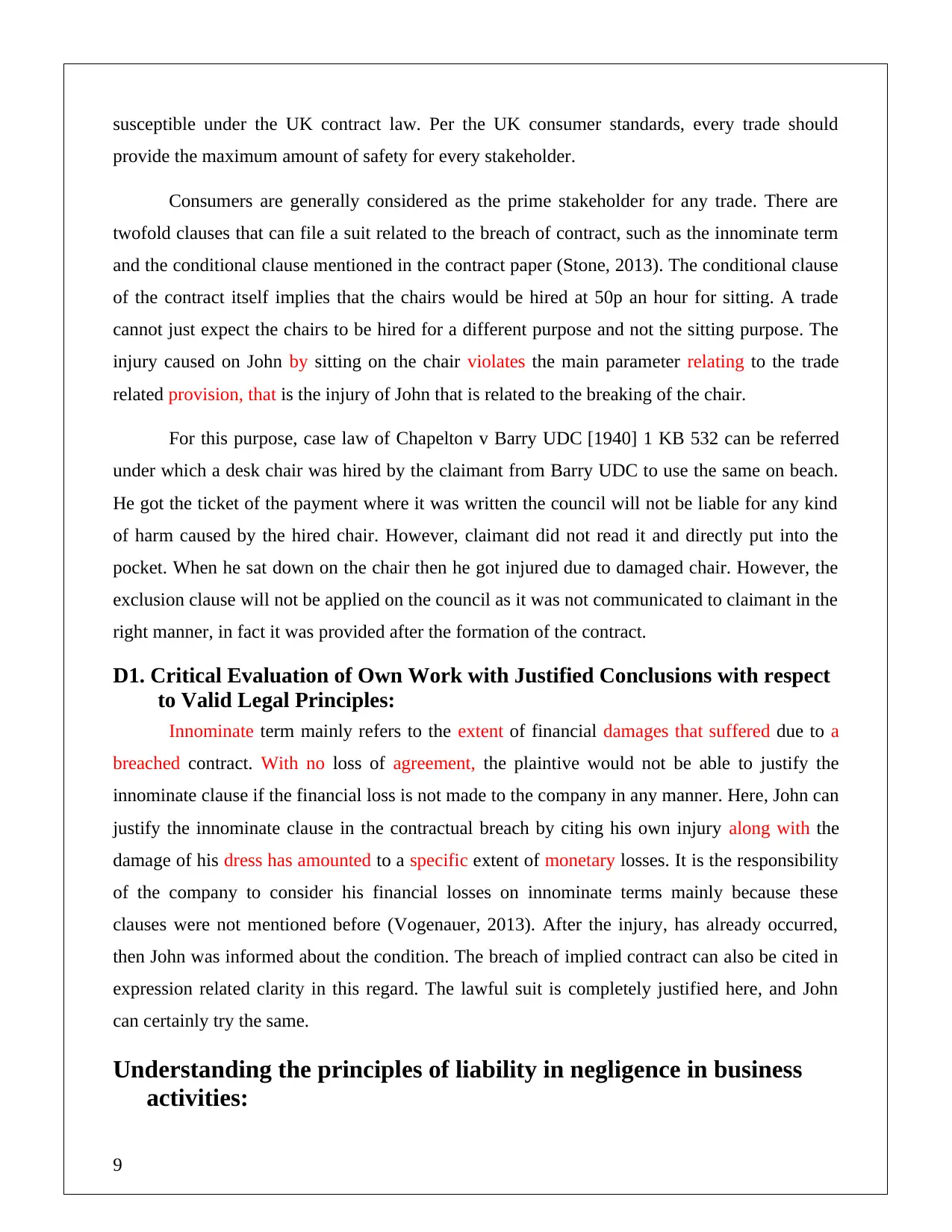
susceptible under the UK contract law. Per the UK consumer standards, every trade should
provide the maximum amount of safety for every stakeholder.
Consumers are generally considered as the prime stakeholder for any trade. There are
twofold clauses that can file a suit related to the breach of contract, such as the innominate term
and the conditional clause mentioned in the contract paper (Stone, 2013). The conditional clause
of the contract itself implies that the chairs would be hired at 50p an hour for sitting. A trade
cannot just expect the chairs to be hired for a different purpose and not the sitting purpose. The
injury caused on John by sitting on the chair violates the main parameter relating to the trade
related provision, that is the injury of John that is related to the breaking of the chair.
For this purpose, case law of Chapelton v Barry UDC [1940] 1 KB 532 can be referred
under which a desk chair was hired by the claimant from Barry UDC to use the same on beach.
He got the ticket of the payment where it was written the council will not be liable for any kind
of harm caused by the hired chair. However, claimant did not read it and directly put into the
pocket. When he sat down on the chair then he got injured due to damaged chair. However, the
exclusion clause will not be applied on the council as it was not communicated to claimant in the
right manner, in fact it was provided after the formation of the contract.
D1. Critical Evaluation of Own Work with Justified Conclusions with respect
to Valid Legal Principles:
Innominate term mainly refers to the extent of financial damages that suffered due to a
breached contract. With no loss of agreement, the plaintive would not be able to justify the
innominate clause if the financial loss is not made to the company in any manner. Here, John can
justify the innominate clause in the contractual breach by citing his own injury along with the
damage of his dress has amounted to a specific extent of monetary losses. It is the responsibility
of the company to consider his financial losses on innominate terms mainly because these
clauses were not mentioned before (Vogenauer, 2013). After the injury, has already occurred,
then John was informed about the condition. The breach of implied contract can also be cited in
expression related clarity in this regard. The lawful suit is completely justified here, and John
can certainly try the same.
Understanding the principles of liability in negligence in business
activities:
9
provide the maximum amount of safety for every stakeholder.
Consumers are generally considered as the prime stakeholder for any trade. There are
twofold clauses that can file a suit related to the breach of contract, such as the innominate term
and the conditional clause mentioned in the contract paper (Stone, 2013). The conditional clause
of the contract itself implies that the chairs would be hired at 50p an hour for sitting. A trade
cannot just expect the chairs to be hired for a different purpose and not the sitting purpose. The
injury caused on John by sitting on the chair violates the main parameter relating to the trade
related provision, that is the injury of John that is related to the breaking of the chair.
For this purpose, case law of Chapelton v Barry UDC [1940] 1 KB 532 can be referred
under which a desk chair was hired by the claimant from Barry UDC to use the same on beach.
He got the ticket of the payment where it was written the council will not be liable for any kind
of harm caused by the hired chair. However, claimant did not read it and directly put into the
pocket. When he sat down on the chair then he got injured due to damaged chair. However, the
exclusion clause will not be applied on the council as it was not communicated to claimant in the
right manner, in fact it was provided after the formation of the contract.
D1. Critical Evaluation of Own Work with Justified Conclusions with respect
to Valid Legal Principles:
Innominate term mainly refers to the extent of financial damages that suffered due to a
breached contract. With no loss of agreement, the plaintive would not be able to justify the
innominate clause if the financial loss is not made to the company in any manner. Here, John can
justify the innominate clause in the contractual breach by citing his own injury along with the
damage of his dress has amounted to a specific extent of monetary losses. It is the responsibility
of the company to consider his financial losses on innominate terms mainly because these
clauses were not mentioned before (Vogenauer, 2013). After the injury, has already occurred,
then John was informed about the condition. The breach of implied contract can also be cited in
expression related clarity in this regard. The lawful suit is completely justified here, and John
can certainly try the same.
Understanding the principles of liability in negligence in business
activities:
9
⊘ This is a preview!⊘
Do you want full access?
Subscribe today to unlock all pages.

Trusted by 1+ million students worldwide
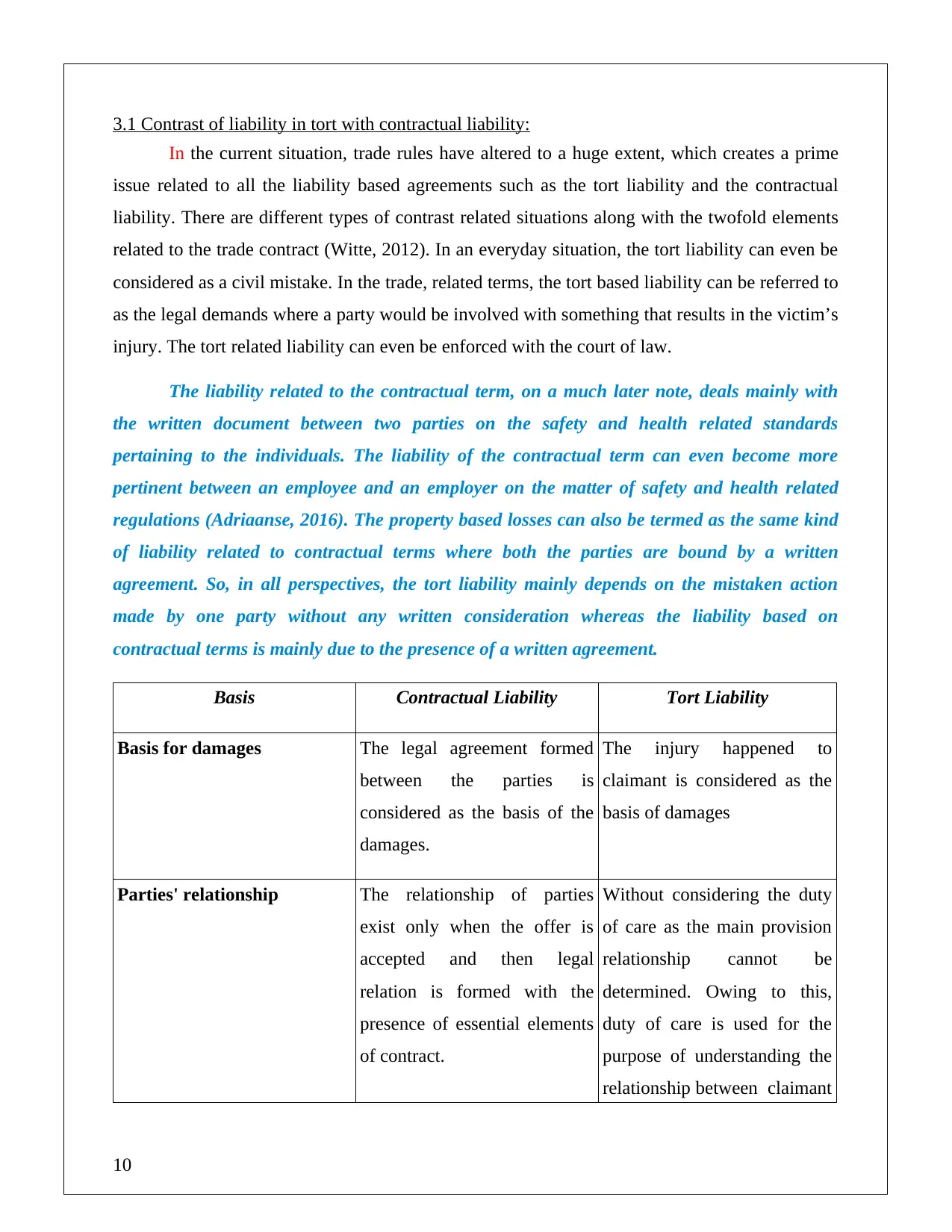
3.1 Contrast of liability in tort with contractual liability:
In the current situation, trade rules have altered to a huge extent, which creates a prime
issue related to all the liability based agreements such as the tort liability and the contractual
liability. There are different types of contrast related situations along with the twofold elements
related to the trade contract (Witte, 2012). In an everyday situation, the tort liability can even be
considered as a civil mistake. In the trade, related terms, the tort based liability can be referred to
as the legal demands where a party would be involved with something that results in the victim’s
injury. The tort related liability can even be enforced with the court of law.
The liability related to the contractual term, on a much later note, deals mainly with
the written document between two parties on the safety and health related standards
pertaining to the individuals. The liability of the contractual term can even become more
pertinent between an employee and an employer on the matter of safety and health related
regulations (Adriaanse, 2016). The property based losses can also be termed as the same kind
of liability related to contractual terms where both the parties are bound by a written
agreement. So, in all perspectives, the tort liability mainly depends on the mistaken action
made by one party without any written consideration whereas the liability based on
contractual terms is mainly due to the presence of a written agreement.
Basis Contractual Liability Tort Liability
Basis for damages The legal agreement formed
between the parties is
considered as the basis of the
damages.
The injury happened to
claimant is considered as the
basis of damages
Parties' relationship The relationship of parties
exist only when the offer is
accepted and then legal
relation is formed with the
presence of essential elements
of contract.
Without considering the duty
of care as the main provision
relationship cannot be
determined. Owing to this,
duty of care is used for the
purpose of understanding the
relationship between claimant
10
In the current situation, trade rules have altered to a huge extent, which creates a prime
issue related to all the liability based agreements such as the tort liability and the contractual
liability. There are different types of contrast related situations along with the twofold elements
related to the trade contract (Witte, 2012). In an everyday situation, the tort liability can even be
considered as a civil mistake. In the trade, related terms, the tort based liability can be referred to
as the legal demands where a party would be involved with something that results in the victim’s
injury. The tort related liability can even be enforced with the court of law.
The liability related to the contractual term, on a much later note, deals mainly with
the written document between two parties on the safety and health related standards
pertaining to the individuals. The liability of the contractual term can even become more
pertinent between an employee and an employer on the matter of safety and health related
regulations (Adriaanse, 2016). The property based losses can also be termed as the same kind
of liability related to contractual terms where both the parties are bound by a written
agreement. So, in all perspectives, the tort liability mainly depends on the mistaken action
made by one party without any written consideration whereas the liability based on
contractual terms is mainly due to the presence of a written agreement.
Basis Contractual Liability Tort Liability
Basis for damages The legal agreement formed
between the parties is
considered as the basis of the
damages.
The injury happened to
claimant is considered as the
basis of damages
Parties' relationship The relationship of parties
exist only when the offer is
accepted and then legal
relation is formed with the
presence of essential elements
of contract.
Without considering the duty
of care as the main provision
relationship cannot be
determined. Owing to this,
duty of care is used for the
purpose of understanding the
relationship between claimant
10
Paraphrase This Document
Need a fresh take? Get an instant paraphrase of this document with our AI Paraphraser
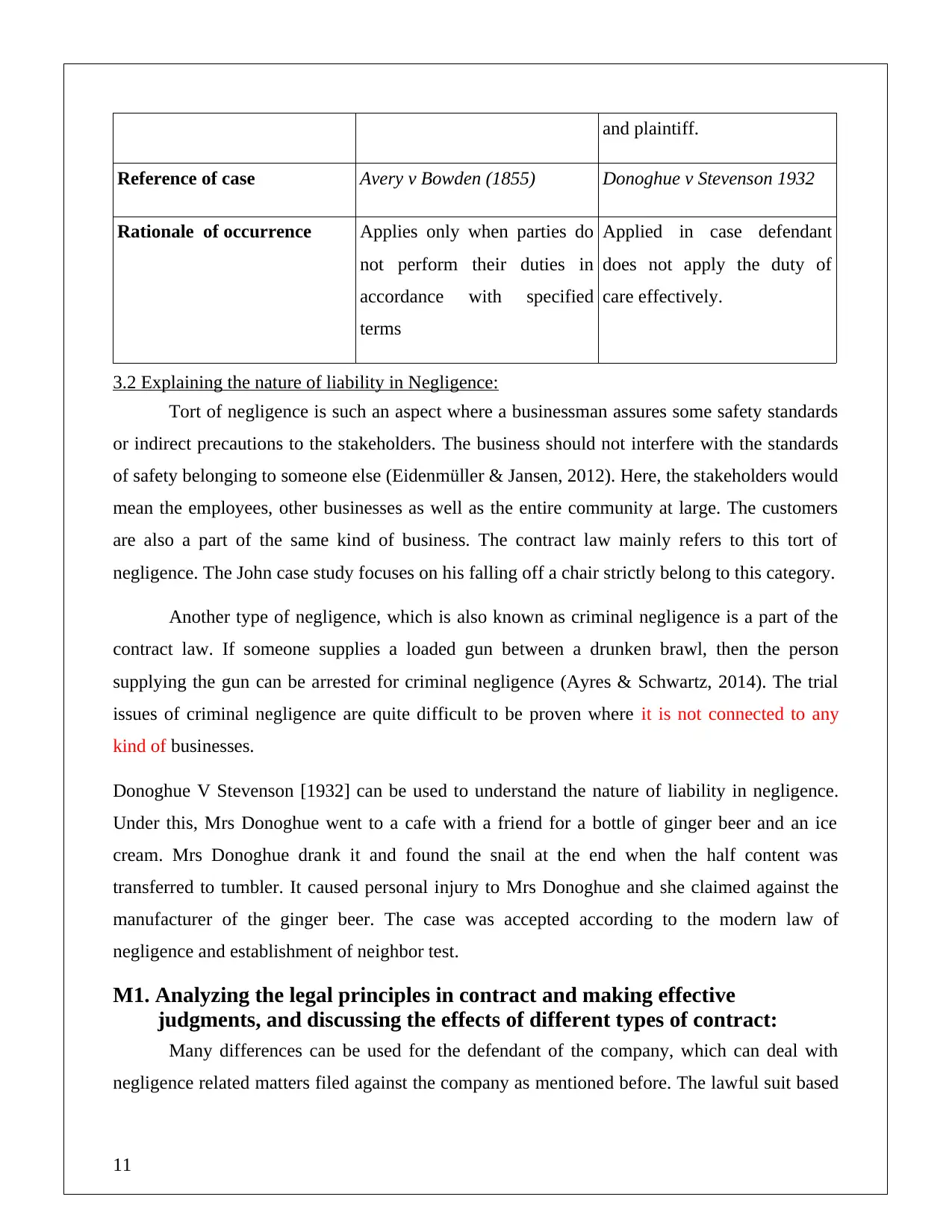
and plaintiff.
Reference of case Avery v Bowden (1855) Donoghue v Stevenson 1932
Rationale of occurrence Applies only when parties do
not perform their duties in
accordance with specified
terms
Applied in case defendant
does not apply the duty of
care effectively.
3.2 Explaining the nature of liability in Negligence:
Tort of negligence is such an aspect where a businessman assures some safety standards
or indirect precautions to the stakeholders. The business should not interfere with the standards
of safety belonging to someone else (Eidenmüller & Jansen, 2012). Here, the stakeholders would
mean the employees, other businesses as well as the entire community at large. The customers
are also a part of the same kind of business. The contract law mainly refers to this tort of
negligence. The John case study focuses on his falling off a chair strictly belong to this category.
Another type of negligence, which is also known as criminal negligence is a part of the
contract law. If someone supplies a loaded gun between a drunken brawl, then the person
supplying the gun can be arrested for criminal negligence (Ayres & Schwartz, 2014). The trial
issues of criminal negligence are quite difficult to be proven where it is not connected to any
kind of businesses.
Donoghue V Stevenson [1932] can be used to understand the nature of liability in negligence.
Under this, Mrs Donoghue went to a cafe with a friend for a bottle of ginger beer and an ice
cream. Mrs Donoghue drank it and found the snail at the end when the half content was
transferred to tumbler. It caused personal injury to Mrs Donoghue and she claimed against the
manufacturer of the ginger beer. The case was accepted according to the modern law of
negligence and establishment of neighbor test.
M1. Analyzing the legal principles in contract and making effective
judgments, and discussing the effects of different types of contract:
Many differences can be used for the defendant of the company, which can deal with
negligence related matters filed against the company as mentioned before. The lawful suit based
11
Reference of case Avery v Bowden (1855) Donoghue v Stevenson 1932
Rationale of occurrence Applies only when parties do
not perform their duties in
accordance with specified
terms
Applied in case defendant
does not apply the duty of
care effectively.
3.2 Explaining the nature of liability in Negligence:
Tort of negligence is such an aspect where a businessman assures some safety standards
or indirect precautions to the stakeholders. The business should not interfere with the standards
of safety belonging to someone else (Eidenmüller & Jansen, 2012). Here, the stakeholders would
mean the employees, other businesses as well as the entire community at large. The customers
are also a part of the same kind of business. The contract law mainly refers to this tort of
negligence. The John case study focuses on his falling off a chair strictly belong to this category.
Another type of negligence, which is also known as criminal negligence is a part of the
contract law. If someone supplies a loaded gun between a drunken brawl, then the person
supplying the gun can be arrested for criminal negligence (Ayres & Schwartz, 2014). The trial
issues of criminal negligence are quite difficult to be proven where it is not connected to any
kind of businesses.
Donoghue V Stevenson [1932] can be used to understand the nature of liability in negligence.
Under this, Mrs Donoghue went to a cafe with a friend for a bottle of ginger beer and an ice
cream. Mrs Donoghue drank it and found the snail at the end when the half content was
transferred to tumbler. It caused personal injury to Mrs Donoghue and she claimed against the
manufacturer of the ginger beer. The case was accepted according to the modern law of
negligence and establishment of neighbor test.
M1. Analyzing the legal principles in contract and making effective
judgments, and discussing the effects of different types of contract:
Many differences can be used for the defendant of the company, which can deal with
negligence related matters filed against the company as mentioned before. The lawful suit based
11
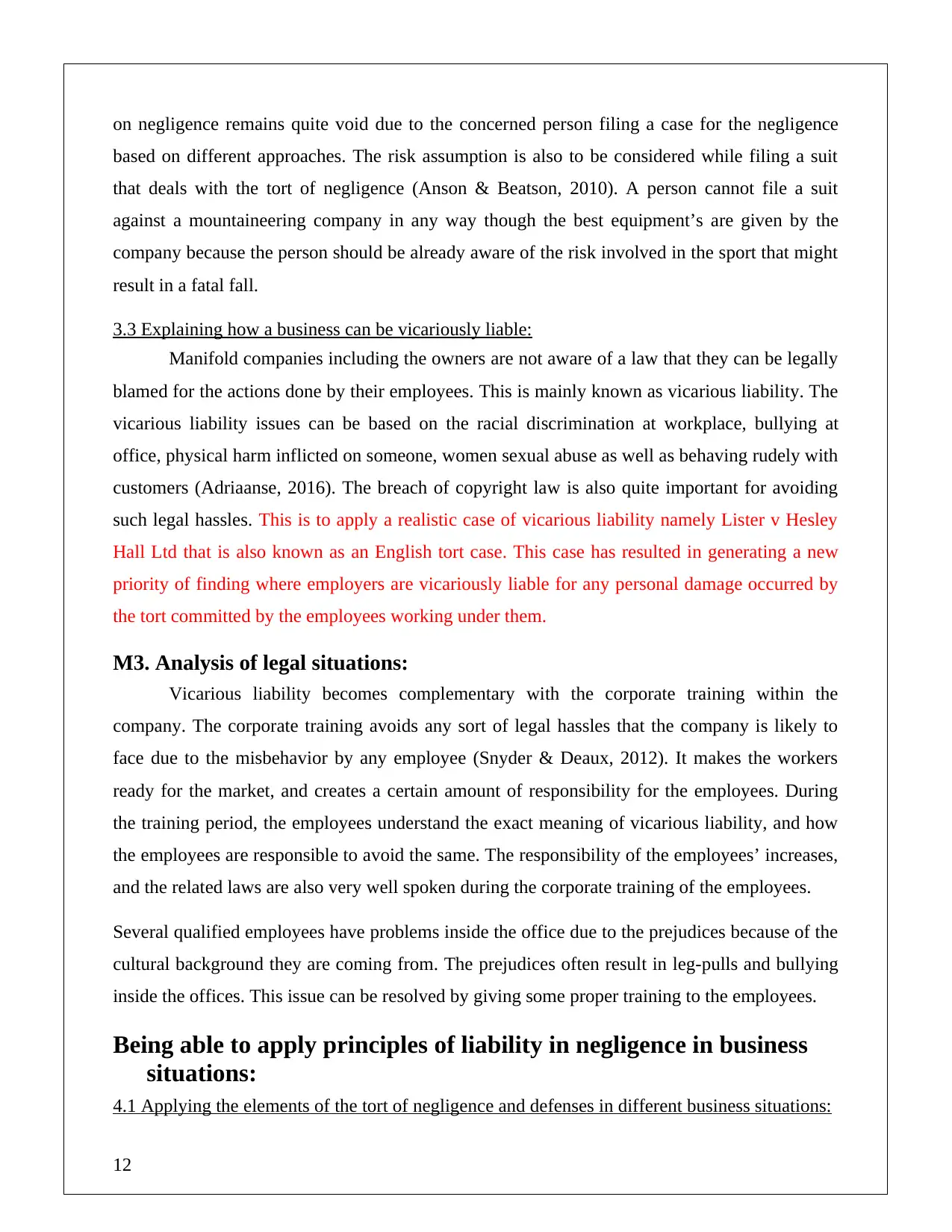
on negligence remains quite void due to the concerned person filing a case for the negligence
based on different approaches. The risk assumption is also to be considered while filing a suit
that deals with the tort of negligence (Anson & Beatson, 2010). A person cannot file a suit
against a mountaineering company in any way though the best equipment’s are given by the
company because the person should be already aware of the risk involved in the sport that might
result in a fatal fall.
3.3 Explaining how a business can be vicariously liable:
Manifold companies including the owners are not aware of a law that they can be legally
blamed for the actions done by their employees. This is mainly known as vicarious liability. The
vicarious liability issues can be based on the racial discrimination at workplace, bullying at
office, physical harm inflicted on someone, women sexual abuse as well as behaving rudely with
customers (Adriaanse, 2016). The breach of copyright law is also quite important for avoiding
such legal hassles. This is to apply a realistic case of vicarious liability namely Lister v Hesley
Hall Ltd that is also known as an English tort case. This case has resulted in generating a new
priority of finding where employers are vicariously liable for any personal damage occurred by
the tort committed by the employees working under them.
M3. Analysis of legal situations:
Vicarious liability becomes complementary with the corporate training within the
company. The corporate training avoids any sort of legal hassles that the company is likely to
face due to the misbehavior by any employee (Snyder & Deaux, 2012). It makes the workers
ready for the market, and creates a certain amount of responsibility for the employees. During
the training period, the employees understand the exact meaning of vicarious liability, and how
the employees are responsible to avoid the same. The responsibility of the employees’ increases,
and the related laws are also very well spoken during the corporate training of the employees.
Several qualified employees have problems inside the office due to the prejudices because of the
cultural background they are coming from. The prejudices often result in leg-pulls and bullying
inside the offices. This issue can be resolved by giving some proper training to the employees.
Being able to apply principles of liability in negligence in business
situations:
4.1 Applying the elements of the tort of negligence and defenses in different business situations:
12
based on different approaches. The risk assumption is also to be considered while filing a suit
that deals with the tort of negligence (Anson & Beatson, 2010). A person cannot file a suit
against a mountaineering company in any way though the best equipment’s are given by the
company because the person should be already aware of the risk involved in the sport that might
result in a fatal fall.
3.3 Explaining how a business can be vicariously liable:
Manifold companies including the owners are not aware of a law that they can be legally
blamed for the actions done by their employees. This is mainly known as vicarious liability. The
vicarious liability issues can be based on the racial discrimination at workplace, bullying at
office, physical harm inflicted on someone, women sexual abuse as well as behaving rudely with
customers (Adriaanse, 2016). The breach of copyright law is also quite important for avoiding
such legal hassles. This is to apply a realistic case of vicarious liability namely Lister v Hesley
Hall Ltd that is also known as an English tort case. This case has resulted in generating a new
priority of finding where employers are vicariously liable for any personal damage occurred by
the tort committed by the employees working under them.
M3. Analysis of legal situations:
Vicarious liability becomes complementary with the corporate training within the
company. The corporate training avoids any sort of legal hassles that the company is likely to
face due to the misbehavior by any employee (Snyder & Deaux, 2012). It makes the workers
ready for the market, and creates a certain amount of responsibility for the employees. During
the training period, the employees understand the exact meaning of vicarious liability, and how
the employees are responsible to avoid the same. The responsibility of the employees’ increases,
and the related laws are also very well spoken during the corporate training of the employees.
Several qualified employees have problems inside the office due to the prejudices because of the
cultural background they are coming from. The prejudices often result in leg-pulls and bullying
inside the offices. This issue can be resolved by giving some proper training to the employees.
Being able to apply principles of liability in negligence in business
situations:
4.1 Applying the elements of the tort of negligence and defenses in different business situations:
12
⊘ This is a preview!⊘
Do you want full access?
Subscribe today to unlock all pages.

Trusted by 1+ million students worldwide
1 out of 17
Related Documents
Your All-in-One AI-Powered Toolkit for Academic Success.
+13062052269
info@desklib.com
Available 24*7 on WhatsApp / Email
![[object Object]](/_next/static/media/star-bottom.7253800d.svg)
Unlock your academic potential
Copyright © 2020–2025 A2Z Services. All Rights Reserved. Developed and managed by ZUCOL.





